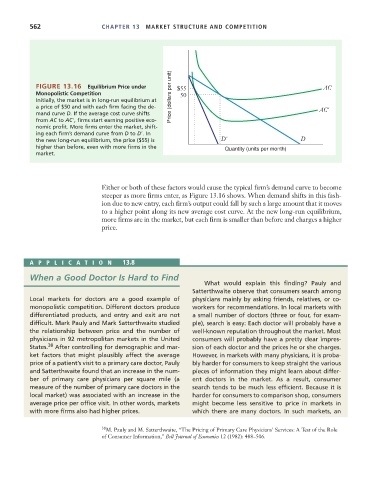Page 588 - Microeconomics, Fourth Edition
P. 588
c13marketstructureandcompetition.qxd 7/30/10 10:44 AM Page 562
562 CHAPTER 13 MARKET STRUCTURE AND COMPETITION
FIGURE 13.16 Equilibrium Price under $55 AC
Monopolistic Competition 50
Initially, the market is in long-run equilibrium at Price (dollars per unit)
a price of $50 and with each firm facing the de- AC'
mand curve D. If the average cost curve shifts
from AC to AC , firms start earning positive eco-
nomic profit. More firms enter the market, shift-
ing each firm’s demand curve from D to D . In
the new long-run equilibrium, the price ($55) is D' D
higher than before, even with more firms in the
Quantity (units per month)
market.
Either or both of these factors would cause the typical firm’s demand curve to become
steeper as more firms enter, as Figure 13.16 shows. When demand shifts in this fash-
ion due to new entry, each firm’s output could fall by such a large amount that it moves
to a higher point along its new average cost curve. At the new long-run equilibrium,
more firms are in the market, but each firm is smaller than before and charges a higher
price.
APPLICA TION 13.8
When a Good Doctor Is Hard to Find
What would explain this finding? Pauly and
Satterthwaite observe that consumers search among
Local markets for doctors are a good example of physicians mainly by asking friends, relatives, or co-
monopolistic competition. Different doctors produce workers for recommendations. In local markets with
differentiated products, and entry and exit are not a small number of doctors (three or four, for exam-
difficult. Mark Pauly and Mark Satterthwaite studied ple), search is easy: Each doctor will probably have a
the relationship between price and the number of well-known reputation throughout the market. Most
physicians in 92 metropolitan markets in the United consumers will probably have a pretty clear impres-
States. 38 After controlling for demographic and mar- sion of each doctor and the prices he or she charges.
ket factors that might plausibly affect the average However, in markets with many physicians, it is proba-
price of a patient’s visit to a primary care doctor, Pauly bly harder for consumers to keep straight the various
and Satterthwaite found that an increase in the num- pieces of information they might learn about differ-
ber of primary care physicians per square mile (a ent doctors in the market. As a result, consumer
measure of the number of primary care doctors in the search tends to be much less efficient. Because it is
local market) was associated with an increase in the harder for consumers to comparison shop, consumers
average price per office visit. In other words, markets might become less sensitive to price in markets in
with more firms also had higher prices. which there are many doctors. In such markets, an
38 M. Pauly and M. Satterthwaite, “The Pricing of Primary Care Physicians’ Services: A Test of the Role
of Consumer Information,” Bell Journal of Economics 12 (1982): 488–506.

